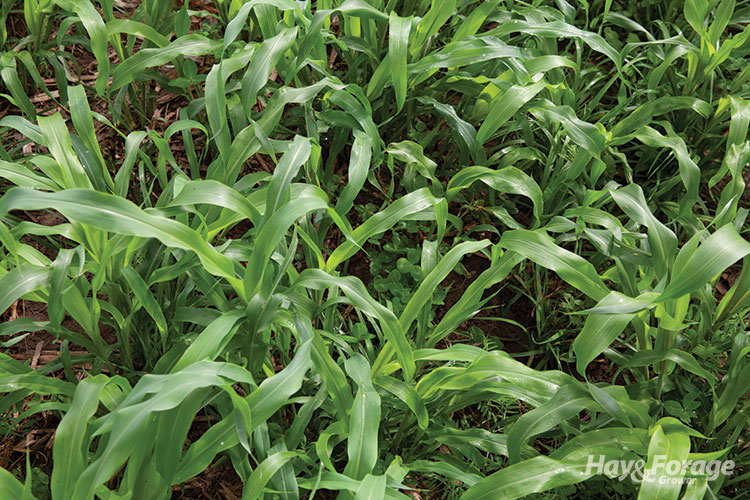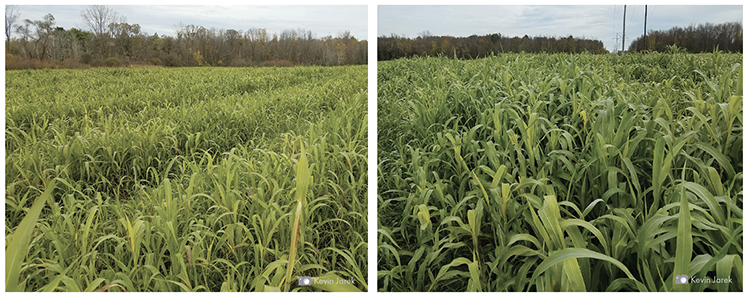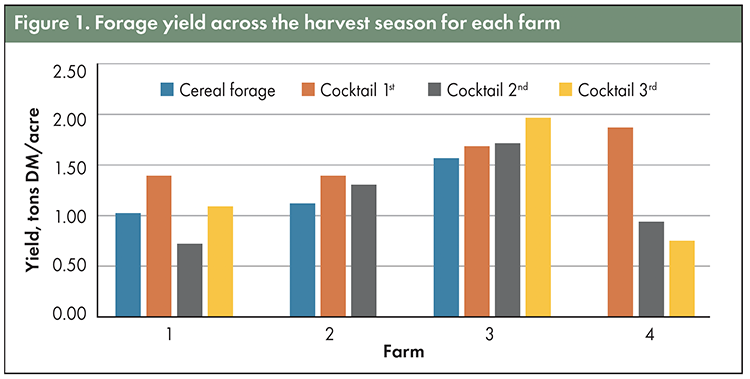Cocktail forage mixes may fit in dairy rations |
| By Matt Akins, Kevin Jarek, and Mike Ballweg |
|
|
|
Akins is an extension dairy scientist with the University of Wisconsin-Madison (UW). Jarek and Ballweg are extension educators with the UW Division of Extension.  As dairy farms utilize more spring-harvested winter cereal forages, cocktail forage mixes are often on the list of options of what to plant next. This is due to their fast growth after planting, the option to apply manure in-season, and the potential for high forage quality. These mixes typically contain a warm-season annual, which is often a brown midrib (BMR) sorghum-sudangrass, Italian ryegrass, and a mix of various legumes, including berseem, crimson, or red clover; hairy vetch; and others. Most mixes contain a high percentage of the warm-season annual and Italian ryegrass because of their quick emergence, growth, and regrowth potential after cutting. In one 2019 Wisconsin field project, a cocktail forage mix planted after a cereal rye crop yielded a total of nearly 4 tons of dry matter (DM) per acre across four harvests. This included 0.7 tons DM per acre from the rye forage. As more producers consider these forages, additional data is needed to understand yield, quality, and variability across farms. To address this, we conducted a project that was supported by the UW Dairy Innovation Hub to gather forage data from four Wisconsin dairy farms. Systems differed Forage yield data were collected from fields at three dairy farms in northeast Wisconsin and from the Marshfield Agricultural Research Station. On the three commercial farms, the cocktail forage mix was planted after a cereal forage harvest in early June. At three of the locations, the mix was seeded at 35 pounds per acre with 60% BMR sorghum-sudangrass, 25% Italian ryegrass, and 15% from a combination of berseem, red clover, and hairy vetch. Farm 4 used a mix seeded at 50 pounds per acre with 59% cowpeas; 17% Italian ryegrass; 6% each of millet, alfalfa, and red clover; 4% timothy; and 2% radish.  Photo 1 (left): Cocktail forage mix without manure applied. Photo 2 (right): Cocktail forage mix with manure applied. The fertilization program varied widely, with Farm 1 applying 9,000 gallons of liquid manure preplant and then 60 pounds of N fertilizer per acre between harvests. Farm 2 applied 66 pounds of N fertilizer per acre preplant and then 6,000 gallons of liquid manure between cuttings. Farm 3 only applied 45 pounds of N fertilizer after each cutting, while Farm 4 applied 20 pounds of N per acre preplant and no subsequent N due to drought. Farms targeted harvest of high-quality forage, with harvests taken at approximately a 24- to 36-inch canopy height of the sorghum-sudangrass. First harvest occurred about 40 to 50 days after planting, second harvest was 30 to 35 days later, and a third harvest had a longer interval of 45 to 60 days with a harvest in late September to mid-October. Overall, total-season forage yields averaged 4.6 tons of DM per acre with a range from 3.7 to 6.9 tons of DM per acre. The cereal forage yields were consistent across farms at 1 to 1.5 tons of DM per acre. Yields of cocktail mix across harvests were more variable, with the first harvest being the highest yielding (1.4 to 1.9 tons of DM per acre) on three of the four farms (see Figure 1).  The second and third harvests were lower for the two farms that used synthetic N fertilizer between harvests (0.7 to 1.1 tons of DM per acre), while the farm that applied liquid manure maintained higher yields (1.7 to 1.9 tons of DM per acre). The photos depict areas in the same field that received or did not receive manure at this farm. It is hard to know exact reasons for the yield differences, but soil fertility is likely a main factor, especially for the sorghum-sudangrass and Italian ryegrass dominant mixtures. Some producers have indicated significant damage to sorghum-sudangrass stands after applying manure to the crop due to wheel traffic and stem breakage, with some considering a mix based on Italian ryegrass to minimize stand damage. Wisconsin researchers are currently working to evaluate N fertility needs for these mixes to determine more precise recommendations. The farm with the lowest season yields (Farm 4) was only able to take two harvests due to drought conditions after emergence. This farm used a mix with mostly cowpeas, which had good early emergence but did not perform well during drought conditions. The farms with mixes based on sorghum-sudangrass had stands that were primarily sorghum-sudangrass for the first harvest, then progressively increased in Italian ryegrass for the second and third harvests. Across all farms, the proportion of legumes was very low (less than 10%). Some farmers are indicating that the Italian ryegrass and certain clovers can overwinter and provide a potential spring harvest of high-quality forage, but this would depend on winter conditions. Cereals shined for quality The cereal forages were excellent quality with 19% crude protein (CP), 43% neutral detergent fiber (NDF), 67% NDF digestibility at 30 hours (NDFD30), 6.7% undigestible NDF at 240 hours (uNDF240), and 72% total digestible nutrients (TDN). This forage would work very well in lactating cow diets. For the cocktail mix, overall quality was a bit lower than expected. Energy was between 53% and 68% TDN with most samples 55% to 63% TDN. The highest TDN sample consisted primarily of Italian ryegrass. Crude protein was moderate and ranged from 8.4% to 16.5%. Protein declined with each subsequent harvest, even with N fertilization between harvests. Fiber content seemed to be consistent across cuttings, ranging from 48% to 56% NDF, except for a third harvest that was 42% NDF and predominantly ryegrass. Fiber digestibility averaged 55% NDFD30 with a range from 41% to 65%. These values were lower than expected considering the species, traits, and harvest targets used. Undigested NDF (uNDF240) was 5% to 12% of the DM, with the lowest sample being predominantly ryegrass. Meanwhile, most of the cocktail mix samples were between 8% and 12%. These forages still fit in lactating cow diets, but inclusion rates would need to be evaluated to avoid reducing intakes. In making decisions about using cocktail mixes, consider how the crop fits in your cropping and feeding systems. It’s also apparent that N fertilizer will be considerably more expensive this year, which will boost input costs. Based on the results of this multi-farm demonstration project, cocktail forage mixes can provide good forage yield and quality with adequate soil fertility and good growing conditions. We plan to evaluate lactating cow productivity when fed a cocktail forage mix. This article appeared in the March 2022 issue of Hay & Forage Grower on pages 26 and 27. Not a subscriber? Click to get the print magazine. |
